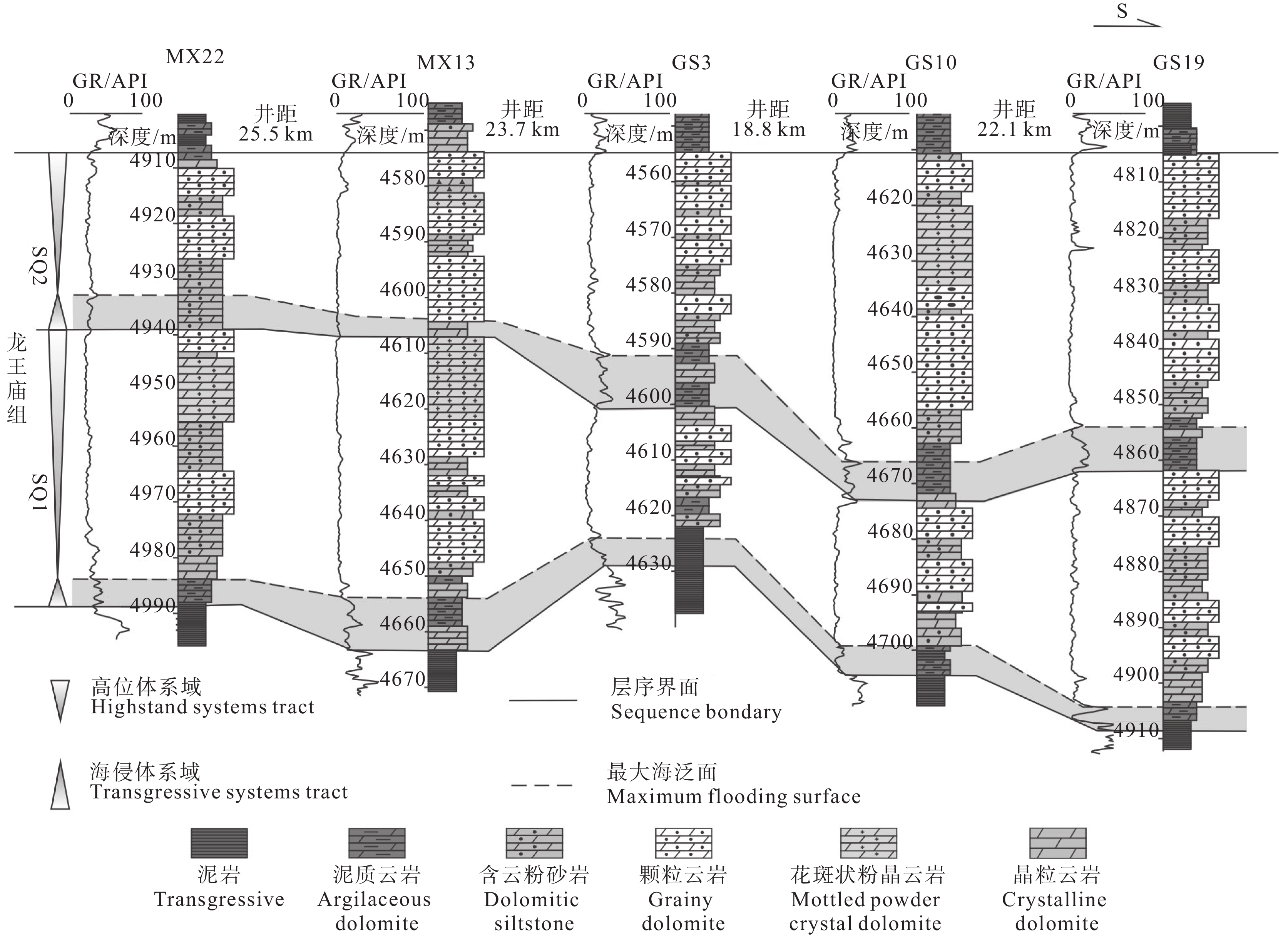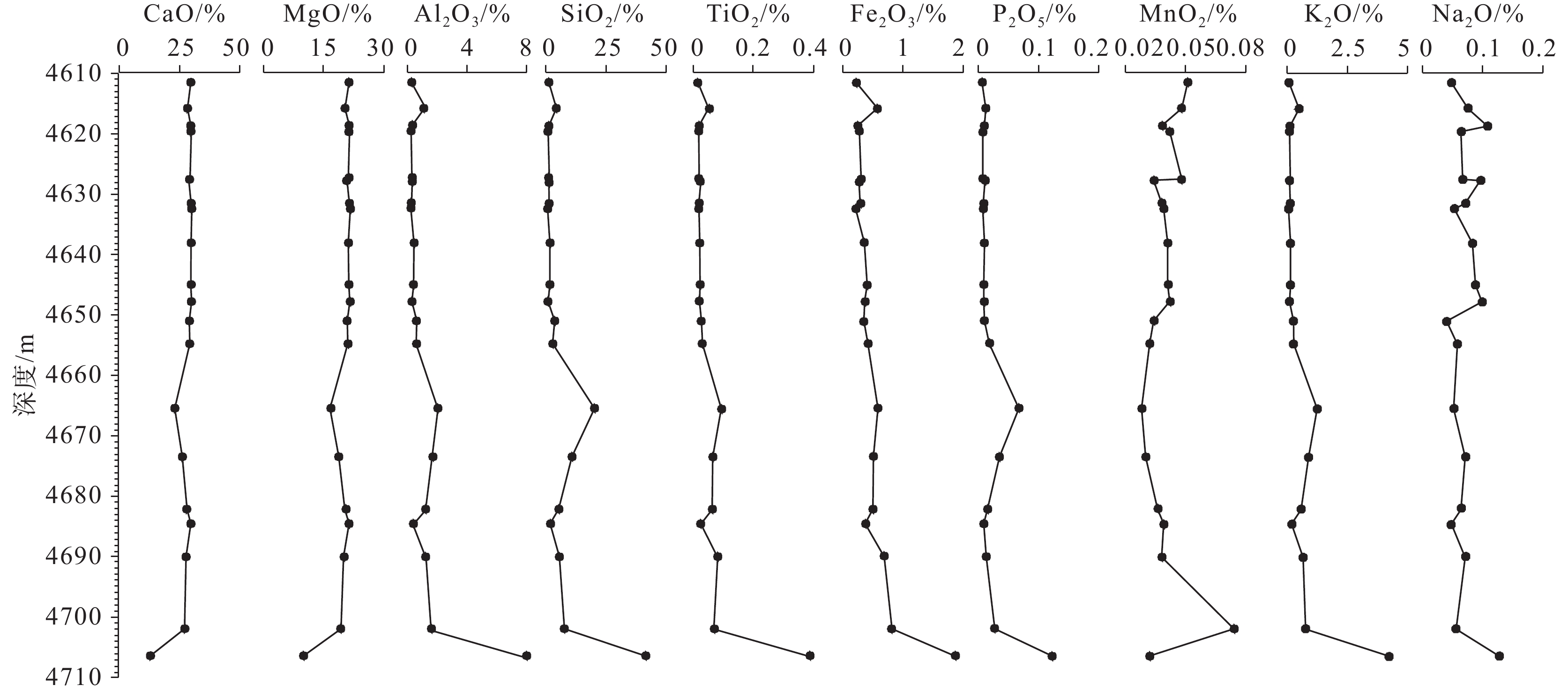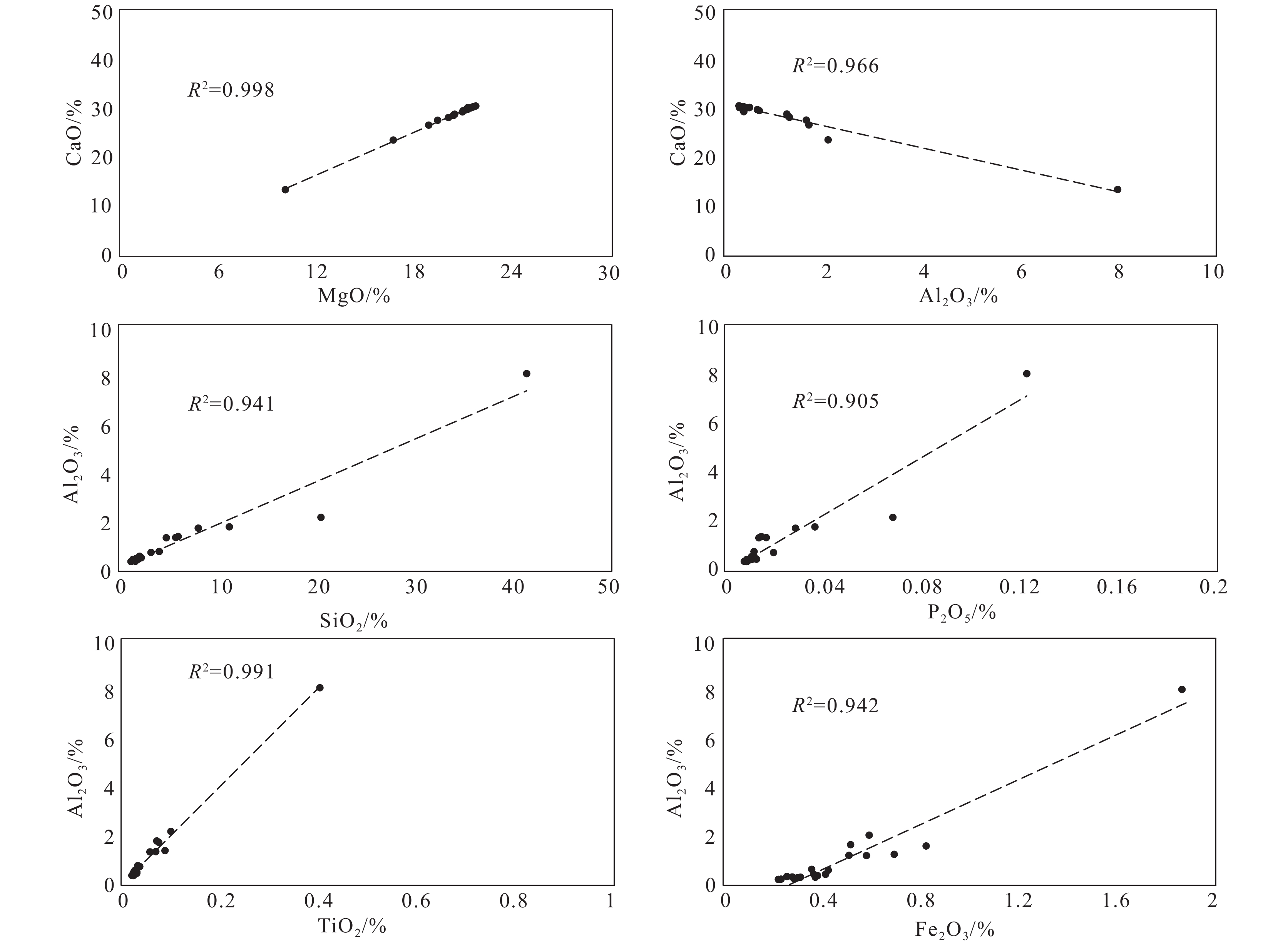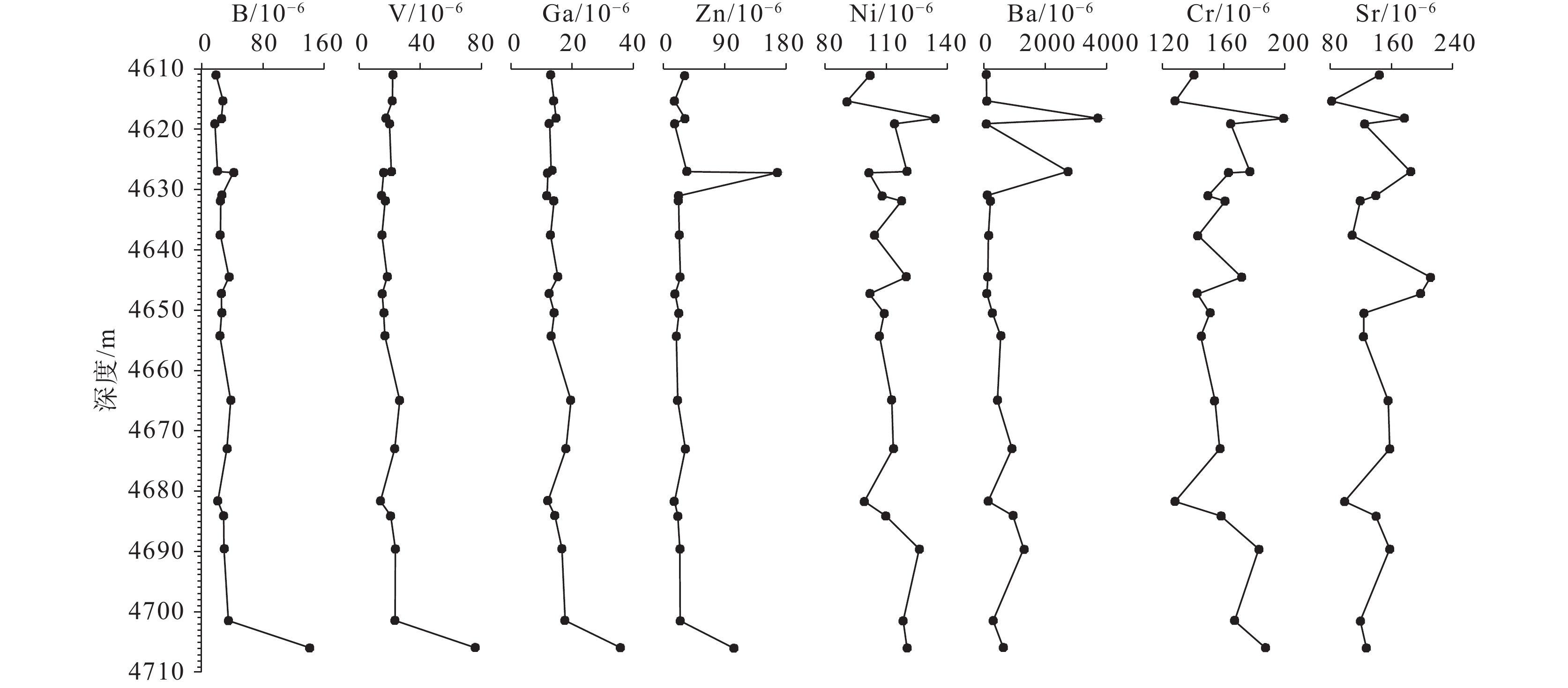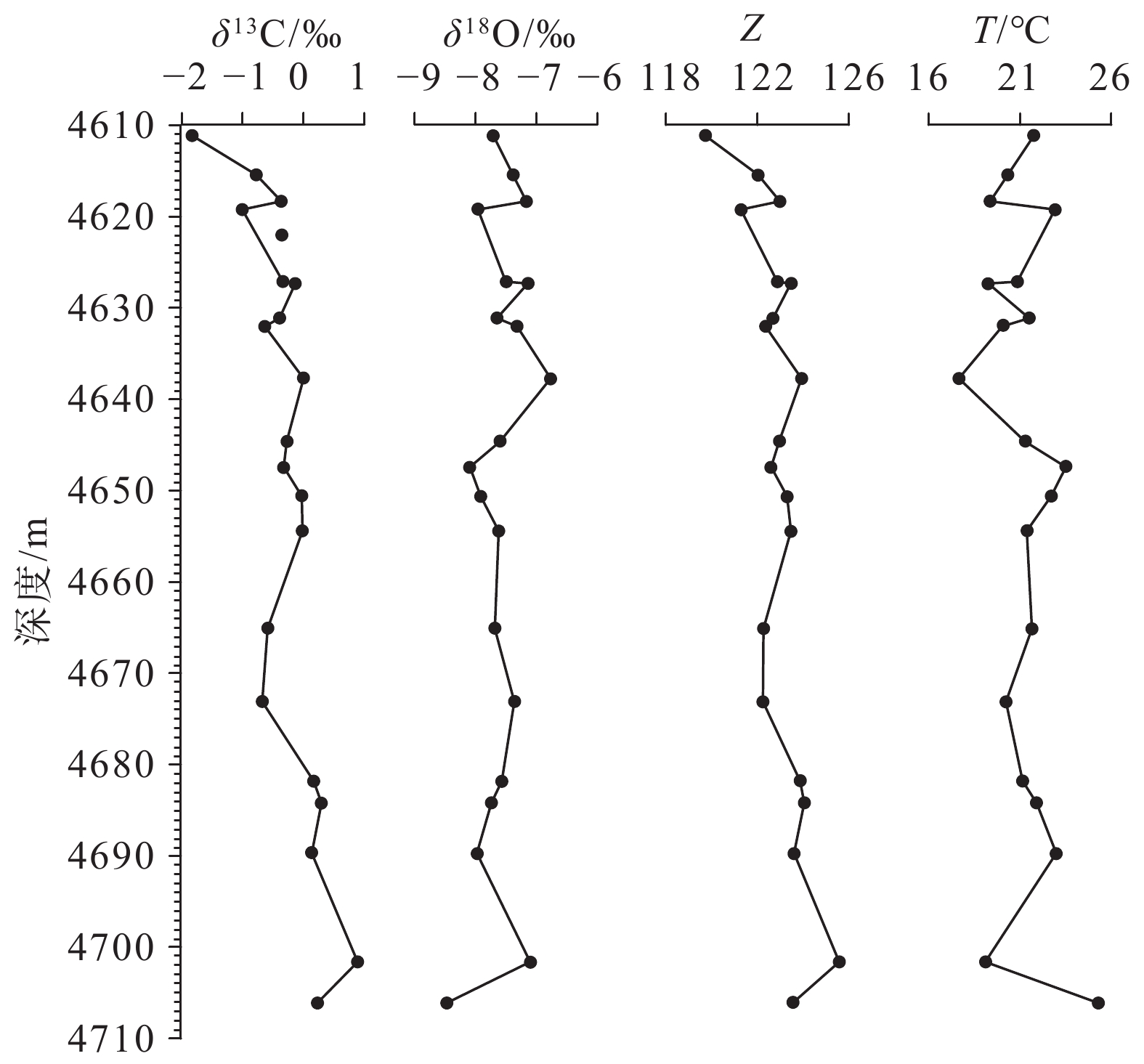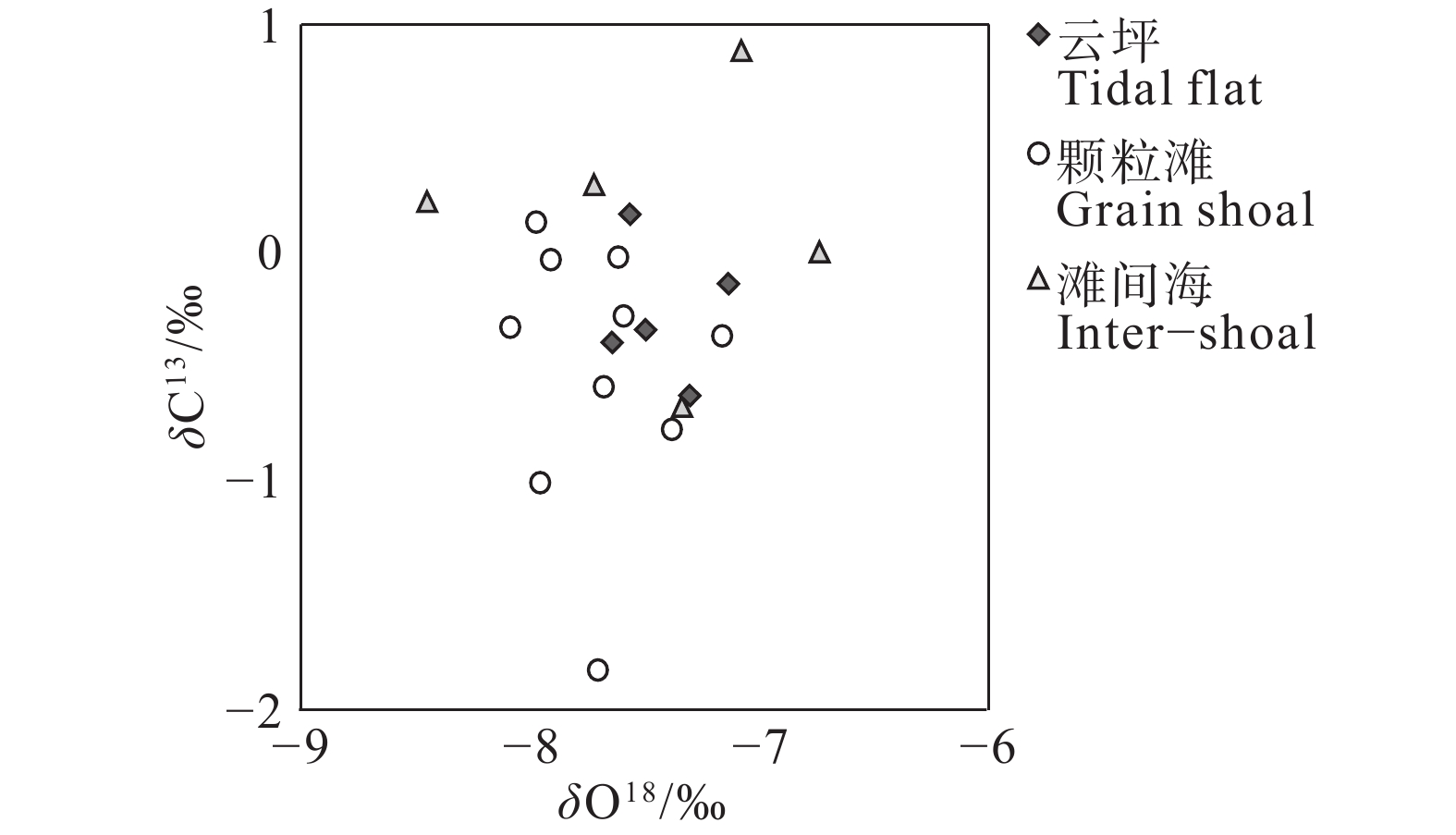Controls of paleoclimate and sea−level changes on the high−frequency sequence of shallow−water carbonates: A case study of the Longwangmiao Formation in the central Sichuan Basin
-
摘要:研究目的
阐明古气候和海平面变化对浅水碳酸盐岩高频层序及有利储层的控制机制,对明确储层成因和分布规律具有重要意义。
研究方法以川中地区龙王庙组为例,在沉积相及层序地层分析的基础上,通过全井段取心的碳氧同位素、主量和微量元素测试,恢复了海平面和古气候变化并开展了综合讨论。
研究结果龙王庙组主要发育云质潟湖、滩间海、颗粒滩和云坪4种沉积微相,可清晰识别可区域对比的两个四级层序。龙王庙组的δ13C具有两个变化周期,指示两次海平面升降,这与Al2O3、TiO2、B和V元素变化所反映的古水深变化一致。碳和氧同位素估算的古海水Z值和温度,以及Mg、Ca良好的相关性,共同反映干旱炎热气候和亚热带海洋环境;MgO/CaO、MnO2、Fe2O3/MnO2和Al2O3/MgO的规律性变化,指示两个层序早期的气候短暂过渡为温暖潮湿;Sr/Ba值反映沉积晚期海水盐度明显增高。
结论气候温暖潮湿和海平面快速上升期形成海侵体系域;气候炎热干旱时,颗粒滩和云坪快速沉积构成高位体系域。高位域上部的滩—坪体系是优质储层的物质基础,在海平面下降和干热气候控制下发生的早期溶蚀和白云化作用是储层改善的关键。
创新点:(1)利用钻井岩心的高密度取样开展的主、微量元素和碳、氧同位素测试,揭示了早寒武世龙王庙组沉积期存在两个海平面升降变化和古气候变化周期;(2)阐明了海平面变化和古气候变化对浅水碳酸盐高频层序和有利储层的控制机制。
Abstract:This paper is the result of oil and gas exploration engineering.
ObjectiveClarifying the control mechanisms of ancient climate and sea level changes on high−frequency sequences and favorable reservoirs of shallow water carbonate rocks is of great significance for clarifying the genesis and distribution patterns of reservoirs.
MethodsMicrofacies and sequence stratigraphy analysis and geochemical analysis including carbon and oxygen isotopes, major and trace elements with core samples were used.
ResultsThe Four types of microfacies including dolomitic lagoon, inter−shoal, grain shoal and tidal flat were identified in the Longwangmiao Formation. The Formation was subdivided into two fourth-order sequences which was regionally correlated. The δ13C of the Longwangmiao Formation vertically shows two periodical changes, which indicates two episodes of sea-level changes. This trend of sea-level change is consistent with the change of water depth reflected by the variations of Al2O3, TiO2, B and V values. Using carbon and oxygen isotopes coupled with the well−correlated Mg and Ca values, the estimated Z values and seawater temperaturesduring the deposition of the Formation collectively reflect arid and hot climates and a subtropical marine environment. Systematic variations in MgO/CaO, MnO2, Fe2O3/MnO2, and Al2O3/MgO values indicate a brief transition to warm and humid conditions during the early stages of the two successions, and the Sr/Ba values reflect the marked increase in late−stage seawater salinity during deposition.
ConclusionsA warm and humid climatecoupled with a rapid rise in sea level, led to the formation of transgressive systems tracts. During the hot and arid climates, rapid deposition of grain shoals and dolomitic tidal flat constitutes the highstand systems tracts. The grain shoal and dolomitic tidal−flat deposits serves as the material basis for high−quality reservoirs. Early dissolution and dolomitization processes occurring during sea−level fall and a hot and arid climate are crucial for reservoir development.
Highlights:(1) Major and trace elements, carbon and oxygen isotopes from high−density sampling of drilling cores was used to reveal two cycles of the of paleoclimate and sea−level changes was revealed during the sedimentary period of the Late Cambrian Longwangmiao Formation in central Sichuan Basin. (2) The controls of paleoclimate and sea−level changes on the high−frequency sequences of shallow−water carbonates are clarified.
-
1. 引 言
浅水碳酸盐岩沉积相带垂向和横向叠置变化快,易形成高频层序。通过建立高频层序地层格架有助于查明有利储集相带的空间分布,因此相关研究是碳酸盐岩沉积学和储层地层学研究的热点之一(Gattolin et al., 2015;高达等,2016,2021,2022;王媛等,2017;江维等,2021;钟寿康等,2022)。控制碳酸盐岩层序发育的主要因素主要包括海平面升降变化、构造沉降和气候条件(Handford and Loucks,1993;Catuneanu and Sweet, 1999)。厚层的浅水碳酸盐岩层系多发育在构造相对稳定时期,许多研究表明,古气候和高频海平面变化是控制高频层序和相分布的主要因素(Gao et al., 2014;高达等,2016;金丽娜等,2016;王媛等,2017;Zhang et al., 2019)。气候主要通过控制盐度和水循环,影响岩相类型和陆源碎屑输入量,进而控制碳酸盐岩层序的发育(Petty, 2010;Frébourg et al., 2012;Gattolin et al., 2015;姜高磊等,2022)。通过地球化学数据分析,如稳定同位素(C、O和Sr同位素)和主量、微量元素(如MgO/CaO、Sr/Ba、Fe/Mn、Mn/Sr、V/(V+Ni)和U/Th等),可以恢复沉积海水的古盐度、古温度、古水深和古氧化还原条件以及海平面变化(鲍志东等,1998;罗顺社和汪凯明,2010;田洋等,2014;任影等,2018)。但是关于古气候和海平面变化如何控制浅水碳酸盐岩高频层序和有利储层发育的研究十分缺乏。
川中地区下寒武统龙王庙组沉积背景为典型的浅水碳酸盐岩局限台地(高达等,2021),构造背景总体为弱挤压,沉积期古气候总体干旱(姚根顺等,2013;魏国齐等,2015;任影等,2018)。前人大量研究认为川中地区龙王庙组可划分为两个四级层序和多个五级层序,主要受海平面升降变化的控制(任大伟等,2018;曾洪流等,2018;Ji et al.,2018;高达等,2021)。但是古气候和海平面变化如何控制区内龙王庙组高频层序及有利储层发育,相关的研究仍不深入。
本文利用川中地区龙王庙组的钻井资料,在微相和高频层序分析的基础上,利用重点井的全井段取心开展地球化学测试,分析古海洋、古气候和古海平面等变化,以明确古气候和海平面对浅水碳酸盐岩层序的控制作用。对于深入理解碳酸盐岩高频层序对古气候和海平面变化的响应机制,以及明确局限台地有利储层发育机制具有重要意义。
2. 区域地质概况
四川盆地是发育在上扬子地台的多期构造叠合盆地(图1)。研究区川中地区位于四川盆地中部。震旦纪至早寒武世期间,四川盆地西部发育了近南北走向的克拉通裂陷带,东部为高石梯—磨溪古隆起,西部为资阳古隆起。早寒武世龙王庙组沉积期,两个古隆起在川中—西南部地区经历了筇竹寺组和沧浪铺组的碎屑岩“填平补齐”作用,隆坳分异趋势减弱、南北向裂陷逐步消亡,建立起乐山—龙女寺古隆起雏形,整体表现为微弱鼻状古隆起的古地貌格局(魏国齐等,2015;杜金虎等,2016)。寒武纪至今,受加里东运动和海西运动的影响明显,乐山—龙女寺古隆起核部被剥蚀,发育鼻状构造。
![]() 图 1 研究区位置及龙王庙组地层柱状图(据高达等,2021修改)Figure 1. Location of study area and stratigraphy of the Longwangmiao Formation (modified from Gao Da et al., 2021).
图 1 研究区位置及龙王庙组地层柱状图(据高达等,2021修改)Figure 1. Location of study area and stratigraphy of the Longwangmiao Formation (modified from Gao Da et al., 2021).川中地区寒武系保存良好,普遍缺失石炭系、泥盆系、志留系和部分奥陶系(杨雪飞等,2015)。龙王庙组位于下寒武统顶部,下伏沧浪铺组岩性以粉砂岩、泥质粉砂岩和泥页岩为主,上覆高台组主要发育粉砂岩和含云粉砂岩。川中地区龙王庙组厚度为80~120 m,主要发育鲕粒云岩、砂屑云岩和泥晶云岩等多种岩相类型,主体为碳酸盐岩局限台地或内缓坡沉积背景,主要发育滩间海、颗粒滩和局限潮坪等相类型(杨雪飞等,2015;杜金虎等,2016;高达等,2021)。
3. 沉积微相与高频层序
3.1 沉积微相类型与特征
在岩心观察和薄片分析基础上,结合测井曲线分析,将高石10井的沉积微相划分为云质潟湖、滩间海、颗粒滩和云坪等四种类型。
3.1.1 云质潟湖
云质潟湖沉积以薄层状含黏土的泥晶云岩为主要特征(图2a),在岩心上观察到毫米级暗色纹层,镜下可见纹层中分布黏土和陆源碎屑颗粒。这些特征反映沉积环境为水循环局限的潮下低能环境,受到陆源碎屑的间歇性影响。该微相常见于龙王庙组的底部,部分钻井中在龙王庙组的中部也有发育。测井曲线表现为高自然伽马(GR)和低电阻率。
![]() 图 2 川中地区龙王庙组典型岩相类型薄片特征a—含泥泥晶云岩,见黏土和陆源碎屑纹层,高石10井,4706 m;b—泥晶—细粉晶云岩,具水平层理,高石10井,4615.3 m;c—粉晶云岩,高石10井,4673 m;d—视域同c,垫纸后清晰的球粒结构;e—细晶云岩,高石10井,4611 m;f—视域同e,垫纸后观察到清晰砂屑结构;g—鲕粒云岩,垫纸后可见浑圆的鲕粒和粒间白云石胶结物,高石10井,4618.2 m;h—细晶云岩,孔洞内充填洁净的白云石和沥青,高石10井,4627 m;i—细晶云岩,具不清晰的残余颗粒结构,高石10井,4627.2 mFigure 2. Thin−section photos of lithofacies of the Longwangmiao Formation in the central Sichuan Basina—Micritic dolomite with clay and terrestrial lamination, well GS10, 4706 m; b—Micritic to silt-crystalline dolomite with horizontal bedding, well GS10, 4615.3 m; c—Silt-crystalline dolomite, well GS10, 4673 m; d—Clear peloid structure after putting a paper under the thin section, same view as figure c; e—Fine-crystalline dolomite, well GS10, 4611 m; f—Clear intraclast structure after putting a paper under the thin section, same view as figure e; g—Oolitic dolomite with round ooids and intergranular cement visible after putting a paper under the thin section, well GS10, 4618.2 m; h—Fine-crystalline dolomite with clean dolomite cement and bitumen filling the vugs, well GS10, 4627 m; i—Fine-crystalline dolomite with unclear grain structure, well GS10, 4627.2 m
图 2 川中地区龙王庙组典型岩相类型薄片特征a—含泥泥晶云岩,见黏土和陆源碎屑纹层,高石10井,4706 m;b—泥晶—细粉晶云岩,具水平层理,高石10井,4615.3 m;c—粉晶云岩,高石10井,4673 m;d—视域同c,垫纸后清晰的球粒结构;e—细晶云岩,高石10井,4611 m;f—视域同e,垫纸后观察到清晰砂屑结构;g—鲕粒云岩,垫纸后可见浑圆的鲕粒和粒间白云石胶结物,高石10井,4618.2 m;h—细晶云岩,孔洞内充填洁净的白云石和沥青,高石10井,4627 m;i—细晶云岩,具不清晰的残余颗粒结构,高石10井,4627.2 mFigure 2. Thin−section photos of lithofacies of the Longwangmiao Formation in the central Sichuan Basina—Micritic dolomite with clay and terrestrial lamination, well GS10, 4706 m; b—Micritic to silt-crystalline dolomite with horizontal bedding, well GS10, 4615.3 m; c—Silt-crystalline dolomite, well GS10, 4673 m; d—Clear peloid structure after putting a paper under the thin section, same view as figure c; e—Fine-crystalline dolomite, well GS10, 4611 m; f—Clear intraclast structure after putting a paper under the thin section, same view as figure e; g—Oolitic dolomite with round ooids and intergranular cement visible after putting a paper under the thin section, well GS10, 4618.2 m; h—Fine-crystalline dolomite with clean dolomite cement and bitumen filling the vugs, well GS10, 4627 m; i—Fine-crystalline dolomite with unclear grain structure, well GS10, 4627.2 m3.1.2 滩间海
滩间海沉积主要以深灰色泥晶云岩和泥晶球粒云岩发育为特征,这些沉积特征反映沉积水动力较弱。泥晶球粒云岩镜下观察多具泥晶–细粉晶结构(图2b、c),部分薄片在显微镜下垫纸后可见细小的球粒(图2d)。该微相通常与颗粒滩微相交互产出,垂向上厚度薄,沉积环境解释为滩体之间相对低能的洼地,位于正常浪基面以下。测井上通过GR比颗粒滩沉积略高。
3.1.3 颗粒滩
颗粒滩沉积主要发育砂屑云岩、鲕粒云岩和砾屑云岩等岩相类型,这些岩相通常连续厚层产出。镜下观察有的仍然保存清晰的颗粒结构,有的因白云岩化作用导致原始结构不清晰,但通过在薄片与载物台之间垫纸可清楚还原(图2 e、f、g)。鲕粒和砂屑通常具有良好的分选,指示持续高能的水动力,沉积环境为浪基面之上至潮间带下部的高能带。在龙王庙组下部,该微相与滩间海微相交互发育;在龙王庙组的上部,该微相通常与云坪微相交互发育。测井曲线上通常以低值箱型的GR曲线为特征。
3.1.4 云坪
云坪沉积主要以浅灰色—灰色粉晶–细晶云岩为主,岩心上通常具有顺层的孔洞或明暗相间的斑状结构(图2h、i)。原始的沉积结构难以辨认和恢复。GR曲线与颗粒滩相似,但通常具有更低的电阻率。该微相常与颗粒滩微相沉积伴生,分布于龙王庙组的中部和顶部。
3.2 高频层序特征
依据钻井测井和岩心所反映的垂向相序特征,识别了关键层序地层界面,结合前人研究成果(任大伟等,2018;高达等,2021),将川中地区龙王庙组划分为两个四级层序,均包括海侵体系域和高位体系域。通过MX22–MX13–GS3–GS10–GS19连井对比剖面(图3)可以看出,该四级层序划分方案在研究区内可良好对比。
在龙王庙组中部的四级层序界面是由厚层颗粒滩或云坪向潟湖沉积突变的相变界面(图3),GR曲线表现为明显的低值箱型向高值齿化形态的突变,反映相对海平面快速上升,由浅水沉积向相对深水沉积转变。四级层序海侵体系域(TST)主要以相对深水的潟湖和滩间海沉积为特征,GR普遍为高值。四级层序高位体系域(HST)以颗粒滩、滩间海和云坪沉积为特征,反映沉积速率增加,可容空间消耗,沉积水体变浅。在SQ2的HST向上部以颗粒滩和云坪的比例增加。在HST内部,存在多个由滩间海—颗粒滩和颗粒滩—云坪微相组合构成的高频沉积旋回,反映小规模的海平面升降变化(图3)。
4. 地球化学测试
4.1 测试方法
样品取自川中地区高石10井龙王庙组取心段。根据岩心观察和地层分层,获取白云岩样品20个。选取不发育裂缝和溶蚀孔洞的样品约20 g磨成粉末后筛至200目,得到3份>5 g的样品粉末,然后同时进行主量、微量元素和碳氧同位素测试。
全岩主量元素含量测试在武汉上谱分析科技有限责任公司利用日本理学PrimusⅡX射线荧光光谱仪(XRF)分析完成。先将200目样品置于10H箱中烘干12 h;再用陶瓷坩埚在1000℃马弗炉中灼烧2 h,计算烧失量;再在铂金坩埚用助熔剂在1150℃熔样炉中熔融14 min,冷却后,然后将玻璃片取出以备XRF测试。
全岩微量元素含量测试在长江大学地球科学学院实验中心进行实验。首先对样品进行微波消解,使用永乐康YMW-HP12微波消解仪和永乐康石墨消解器。首先进行样品的预消解,后放入石墨消解器内,加热至90℃,直至反应变缓。随后,在微波消解仪内按照设定程序进行消解。之后放入石墨消解器内,加热至170℃赶酸。随后,加入2 mL硝酸,再蒸至近干,再加入4 mL34%的硝酸溶解。最后,冷却至室温后,转入聚乙烯料瓶并定容至45 mL。采用1%的硝酸逐级稀释至所需质量浓度(内标为Ge和In),后使用日本岛津ICP−MS2030系列电感耦合等离子体发射质谱仪测试。
碳氧同位素测试在长江大学地球科学学院实验中心进行实验,仪器为德国赛默飞世尔科学公司生产的Delta V Advantage气体同位素比值质谱仪。实验方法为磷酸法,在高真空条件下用100%磷酸在(25±0.1)℃下反应24 h。然后将收集到的CO2气体送入MAT−252稳定同位素气体质谱仪进行碳氧同位素测定。试验所用标准样品为iaea-co-8方解石,试验结果以PDB标准。碳同位素实验误差为0.022‰,氧同位素实验误差为0.035‰。
4.2 主量元素
4.2.1 总体特征
CaO是测试样品中的首要的氧化物,其含量范围较大(12.77%~30.08%),平均值为27.32%。MgO的含量仅次于CaO,变化范围适中(9.87%~21.6%),平均值为19.63%。Al2O3的含量总体较低,范围为0.20%~7.97%,平均值为1.34%。Na2O、K2O、MnO、TiO2和P2O5的含量非常低,平均值分别为0.07%、0.69%、0.04%、0.07%和0.02%(图4)。
通过制作散点图和线性拟合分析了主量元素之间的相关性(图5)。MgO和CaO具有明显的正相关,CaO与其他氧化物(Al2O3、SiO2、P2O5、TiO2、NaO2、K2O和Fe2O3)均呈明显负相关,Al2O3与多种氧化物(SiO2、P2O5、TiO2、NaO2、K2O和Fe2O3)呈明显正相关。
4.2.2 垂向分布
CaO和MgO的含量在垂向分布上具有一致性(图4)。总体上,从底到顶表现出两个先增大、后减小的旋回。两种元素含量在底部向上突然增大,向上至4665 m逐渐减小。在4665 m之上,由先快速增大、后逐渐趋于稳定,在4627.2 m和4619.1 m处存在小幅振荡。
SiO2、TiO2、Al2O3、Fe2O3和P2O5的含量在垂向上具有相似的变化,变化趋势大致与CaO和MgO的垂向变化相反(图4)。总体上,分布了两个先增大、后减小的旋回。5种元素在底部的含量值均为最大,向上先突然减小、后逐渐增大,在4684.1 m达到极小值。从4665 m往上5种元素先快速减小,在4654.3 m处达到极小值后稳定,4615.3 m处存在波动。
4.3 微量元素
4.3.1 总体特征
龙王庙组样品微量元素中,Ba元素含量范围较大(66.28×10−6~3710.53×10−6),平均值671.9×10−6。B、V、Ga、Zn、Ni、Cr和Sr的含量总体较低,平均值分别为32.98×10−6、21.80×10−6、15.44×10−6、141.62×10−6、111.37×10−6、158.54×10−6和34.32×10−6(图6)。
4.3.2 垂向分布
垂向上,B、V、Ga和Zn在底部为高值向上明显减小,中部(4673 m)微弱增大,上部总体为低值。Ni、Ba、Сr和Sr在下部先增大、后减小,在中部略微增加,上部明显振荡(图6)。
4.4 碳、氧同位素
4.4.1 总体特征
样品δ13C变化范围为−1.83‰~0.889‰,平均值为−0.2842‰。δ13C在垂向上总体表现为2个先增大后减小的旋回。4706~4673 m段,δ13C明显大于平均值,向上至4699 m明显减小。4706~4672 m段旋回先缓慢增加、后逐渐减小,上部具有小幅波动(图7)。
龙王庙组δ18O值变化区间为−8.47‰~−6.76‰,平均值为−7.58‰。在4706~4673 m段,δ18O含量大部分低于平均值,表现出先突然增大、后逐步减小的变化。4672~4637.6 m,总体呈现先减小、后增大的变化旋回。4637.6~4611 m段δ18O在平均值附近波动,在4637.6 m处由极大值向上减小,内部具有两次小幅增加(图7)。
4.4.2 不同微相的碳、氧同位素分布差异
不同微相的碳氧同位素分布存在一定差异。其中,云坪和颗粒滩微相的碳、氧同位素散点图大部分重叠,说明两种微相的δ13C和δ18O差异小。滩间海微相的δ13C比云坪和颗粒滩微相的δ13C略大,平均值为0.15‰(图8)。
5. 讨 论
5.1 数据有效性
元素和同位素对海相碳酸盐岩成岩环境变化敏感,成岩蚀变作用和陆源碎屑的供给都会造成成岩元素差异性富集和分馏,从而改变碳酸盐岩对古环境的原始记录(赵宗举,2015;任影等,2018)。为了准确表征沉积期古海洋条件,有必要对样品的稳定同位素和主、微量元素进行有效性评估。
碳酸盐岩碳、氧同位素易受到成岩作用使得流体性质改变和重结晶,尤其是在淡水淋滤和成岩蚀变条件下,δ18O比δ13C更易改变(Kump, 1991)。因此,δ18O的变化可以作为反映碳酸盐岩成岩蚀变强度的指标。通常认为当δ18O<−10‰(VPDB)时,碳酸盐岩已发生强烈的成岩蚀变作用,样品中的碳、氧同位素已被改造明显;当−10‰<δ18O<−5‰(VPDB)时,碳酸盐岩虽已发生成岩蚀变作用,但碳、氧同位素数据仍具有一定海水沉积期的代表性(Haq and Schutter,2008;任影等,2018)。并且,Horacek et al.(2007)研究发现若碳、氧同位素之间存在相关性,表明碳氧同位素在成岩过程中发生了协同变化,对海水的代表性较差;若碳、氧同位素之间存在微弱相关性或不存在相关性,则说明成岩作用对其影响较小。Mn/Sr比值也可用来判断碳酸盐岩经历的成岩蚀变程度,通常认为当Mn/Sr≤2.0时,碳酸盐岩经受的成岩作用和蚀变程度低(Derry and Brasier, 1994;田洋等,2014;任影等,2018)。研究区龙王庙组20个样品的δ18O在−6‰~−9‰,均大于−10‰且小于−5‰(图7,图8),且δ18O和δ13C之间几乎不具相关性(图8),Mn/Sr值均小于0.6。这些特征说明龙王庙组碳酸盐岩仅受到较低程度的成岩蚀变改造,测试的碳、氧同位素和元素等数据对于沉积海水的原始信息具有一定代表性,可以满足古气候和古海平面分析的要求。
5.2 海平面变化和古水深
5.2.1 碳同位素和海平面变化
全球长期碳循环库主要包括沉积碳酸盐岩(富含13C)和沉积有机质(富含12C)。当全球海平面上升时,深水区易于保存富含有机质的沉积,从海洋中消耗大量12C。同时,由于陆地剥蚀区面积的减小,经流水带入海洋中的12C的量减少。这两种过程共同导致海水中更加富集13C。与之相应的,浅水碳酸盐岩记录的δ13C发生正偏移(李儒峰和刘本培,1996;李玉成等,1998)。因此,海相碳酸盐岩沉积物中的δ13C变重反映全球海平面相对升高,反之则指示全球海平面相对下降(王传尚等,2014;赵宗举,2015;高达等,2021)。高石10井龙王庙组δ13C主要表现为两个先增大、后减小的旋回,反映该沉积期经历了两次完整的海平面变化周期,与四级层序所反映的相对海平面变化一致(图9)。龙王庙组SQ1底部δ13C为最高值,表明此时海平面快速海侵,广泛发育深水台地相;SQ2底部δ13C微弱增大,说明此时发生小规模海侵。在SQ2−HST内部存在多个海平面变化旋回,与高频层序对应良好(图9)。在龙王庙组顶部,δ13C存在明显负偏移,反映龙王庙组沉积物晚期受到大气淡水改造。
5.2.2 元素变化与古水深
Al2O3、SiO2和TiO2的含量可以指示黏土矿物等陆源碎屑物质的供给(田景春等,2006;罗顺社等,2011;田洋等,2014),B和V元素易被黏土质点吸附(汪凯明和罗顺社,2009)。碳酸盐岩中的CaO和MgO主要源于海水的化学沉淀。在深水和低能环境中,通常由于细粒陆源碎屑和黏土的混入造成Al2O3、SiO2和TiO2等含量增加和CaO和MgO含量降低。在龙王庙组的底部和中部(4700~4706 m、4653~4665 m)含泥云岩的层段,Al2O3、SiO2、TiO2、B和V明显增加,CaO和MgO含量降低。反映龙王庙组沉积早期和中期存在两次明显的水体加深,沉积环境转变为相对深水的局限潟湖,陆源碎屑注入有所增加。
碳酸盐岩中的P含量主要取决于海洋生物在沉积物中的保存程度,通常浅海中相对深水和低能的背景更加利于P在碳酸盐沉积物中的富集(罗顺社等,2011)。该井中P2O5含量增大的层段均以发育富含生物碎屑的岩相为主,也指示着水体加深和水循环变通畅,利于生物的繁殖。
5.3 古气候变化
碳酸盐岩中的氧同位素可以用来估算沉积期海水温度,通常使用Epstein and Mayeda(1953)提出的经验公式:
T(℃)=15.976−4.2×δ18O+0.13×(δ18O+0.22)2 (1) 针对中生代以前的碳酸盐岩地层,需要先校正后计算(邵龙义,1994)。首先用样品的δ18O平均值(−7.588‰)减去第四纪海相石灰岩δ18O平均值(−1.22‰),得差值为6.388‰,再将各样品的δ18O值减去该差值得到校正数值,后利用上述公式计算古温度,算出研究区龙王庙组沉积期古海水温度为17.57 ℃~25.19 ℃(平均值21.16 ℃)。这与前人根据龙王庙组氧同位素计算恢复的古温度相近(田洋等,2014;任影等,2018)。反映沉积期古气候较炎热。
碳酸盐岩中的碳、氧同位素(邵龙义,1994)和Sr/Ba(刘林等,2023)可以反映沉积水体古盐度。Keith and Weber(1964)提出用Z值来指示古盐度,经验公式为:
Z=2.048×(δ13C+50)+0.498×(δ18O+50) (2) 根据公式(2)计算得到研究区龙王庙组样品Z值范围为119.7~125.6,均值为122.9。通常认为Z>120指示海相(或陆相湖泊咸水)灰(云)岩(Keith et al., 1964)。研究样品的Z值数据反映龙王庙组为正常海相碳酸盐岩沉积。龙王庙组顶部样品的Z值略低于120,推测原因为大气淡水的影响。
在淡水环境中,Sr与Ba都以离子形式赋存于水中,并且不易沉淀(Das and Haake,2003;Jin et al., 2006)。当水体盐度增加,Ba离子易与SO42− 形成BaSO4沉淀。但Sr的溶解度较大,不易形成沉淀,能够迁移至远海,因此,Sr/Ba高值指示盐度增加(罗顺社和汪凯明,2010;梁文君等,2015;江维等,2021)。在龙王庙组SQ1和SQ2下部,Sr/Ba值较低;在SQ2−HST上部,Sr/Ba值明显增大,且存在多次显著振荡。这表明龙王庙组SQ1沉积早期和SQ2沉积早期沉积水体的盐度为正常海水盐度,晚期盐度升高。在SQ2−HST期,沉积水体受到周期性大气淡水的影响。
白云岩中的MgO与CaO可以反映古气候背景。MgO/CaO比值接近白云岩化学计量组成且MgO和CaO的正相关通常指示准同生期白云石化成因(孙海涛等,2018)。该井样品MgO/CaO比值较高(0.70~0.77),并且MgO和CaO呈现良好的正相关,指示沉积期的气候总体为适宜早期白云岩化作用的炎热干旱气候。
碳酸盐岩中的MnO2和Fe2O3/MnO2反映古气候的变化。Fe主要来源于陆源输入;Mn主要富集在深水,在海水强烈蒸发时,才能在浅水碳酸盐沉积物中大量沉淀聚集(宋明水,2005;任影等,2018)。因此,MnO2的增加和Fe2O3/MnO2的减小可共同指示气候向炎热干旱转变。在龙王庙组SQ1下部,MnO2先迅速增加,后缓慢减小;Fe2O3/MnO2先显著减小,后逐渐增加。这些变化共同指示古气候经历了短暂的温暖湿润后,转变为炎热干旱。向上MnO2逐渐减小,在SQ2顶部,MnO2缓慢增加并且有略微振荡,Fe2O3/MnO2缓慢减小。说明气候变得更加炎热干旱。
此外,Al2O3/MgO的高值反映陆源碎屑和黏土物质的混入,指示气候变得温暖潮湿、河流注入量增加(熊小辉和肖加飞,2011)。Al2O3/MgO值在底部由高值突变为低值,指示沉积期间气候温暖湿润。向上在SQ2底部由高值缓慢减小,说明向炎热干旱气候转变。
综上所述,川中地区龙王庙组沉积期平均温度为21.16℃,气候总体干热。Z值平均为122.9,说明该沉积期为亚热带正常海洋沉积,Sr/Ba反映SQ2沉积晚期盐度明显增高。MgO/CaO指示气候总体炎热干旱,MnO2、Fe2O3/MnO2和Al2O3/MgO的规律性变化反映SQ1早期和SQ2早期经历了短暂的温暖湿润气候。
5.4 古气候和海平面变化对高频层序的控制
综合分析表明,龙王庙组的高频层序明显受到海平面变化和古气候共同控制。碳、氧同位素和元素地球化学数据所反映的海平面升降、古水深、古温度、古盐度和古气候变化与层序和体系域内沉积演化具有良好的对应关系。
龙王庙组中部的四级层序界面处,GR值明显增大,由箱型变为锯齿型;沉积微相由颗粒滩突变为局限潟湖沉积(图3,图9)。与古水深有关的元素(Al2O3、TiO2、B和V)由低值缓慢变为高值,反映古气候的元素指标(Fe2O3/MnO2和Fe2O3/MgO)由低值缓慢增大,说明古温度缓慢上升。碳同位素由负偏移缓慢变为正偏移,反映海平面缓慢上升,气候逐步过渡为温暖背景(图9)。
SQ1和SQ2沉积早期,气候温暖潮湿,海平面上升,水深增加。分析其原因为温暖气候适宜陆上河流的大量发育,陆源碎屑供给量有一定程度的增加。通畅的水循环条件与温暖的气候环境适宜生物的大量生长。相序分析表明龙王庙组SQ1和SQ2沉积早期为海侵体系域(TST),碳酸盐岩产率较低,主要发育含泥云岩的深水台地相。SQ1和SQ2沉积晚期,气候炎热干旱,海平面下降,水体变浅。水循环变差,陆源供给量减少,蒸发作用强烈,抑制了生物的繁殖。通过相序结构分析龙王庙组SQ1和SQ2沉积晚期主要发育高位体系域(HST),广泛的发生早期白云岩化作用。台地内部碳酸盐岩产率进一步增高,滩和云坪叠置发育。
总体上,在温暖潮湿气候和海平面上升时期,可容空间快速增大,碳酸盐岩产率降低。表现为海侵体系域(TST)(退积),以深水台地沉积为主。在干旱气候和海平面下降的背景,适宜发生白云岩化作用。可容空间快速消耗,碳酸盐岩产率有所升高。发育高位体系域(HST),表现为进积(或加积)的颗粒滩和云坪沉积。
5.5 古气候和海平面变化对有利储层的控制
川中地区龙王庙组有利储层的沉积基础为颗粒滩和云坪等,这些微相的分布受到高频层序地层格架的约束,前人已开展大量深入研究(杜金虎等,2016;任大伟等,2018;高达等,2021)。通过恢复古气候和海平面变化发现,储层改善的重要作用——早期岩溶作用和白云化作用,共同受到了古气候和海平面变化的控制。龙王庙组沉积时期总体位于水体较浅的局限台地内,在两次海平面下降促进了颗粒滩和云坪沉积的广泛分布(高达等,2021)。同时,在干热的气候背景下,局限台地的潟湖和滩间洼地中海水不断浓缩,促进了如蒸发泵白云化和渗透−回流白云化作用,使得云坪沉积得以重结晶形成晶间孔,颗粒滩沉积发生云化进而减弱了埋藏压实作用和方解石胶结作用对储层孔隙的破坏。局限台地内的云坪和颗粒滩通常沉积成地貌高地,在海平面下降的背景下受到大气淡水溶蚀作用,形成早期的顺层状分布的溶孔(姚根顺等,2013;杨雪飞等,2015;杜金虎等,2016)。这些作用共同形成了极其有利的天然气储层,构成了川中龙王庙特大型天然气藏形成的基础。
近年来,干热气候背景的浅水碳酸盐岩台地白云岩储层受到广泛关注(胡安平等,2019;Prince et al, 2019;文华国等,2021;Xiao et al, 2021),因其在国内外海相盆地的白云岩−蒸发岩共生体系地层发现了优质的油气储层和巨大的油气储量,例如中国塔里木盆地寒武系盐下白云岩、四川盆地三叠系嘉二段和寒武系龙王庙组、鄂尔多斯盆地奥陶系马五段等。文华国等(2021)总结了白云岩蒸发岩共生体系的沉积和成岩作用及其对储层的控制作用,Xiao et al.(2021)总结了蒸发岩−碳酸盐岩组合主要的成因模式,并基于鄂尔多斯盆地马五段的沉积储层发育特征,提出了新的陆表海型盆地蒸发岩—碳酸盐岩共生模式和铸模孔型储层成因机制。基于川中地区龙王庙组的研究表明,在局限台地滩—坪体系背景下,古气候和海平面变化是优质储层发育的主要控制因素,明确这种机制对于浅水碳酸盐岩台地有利储层的预测具有重要意义。
6. 结 论
(1)川中地区龙王庙组可分为云质潟湖、滩间海、颗粒滩和云坪4种沉积微相类型。龙王庙组可划分为2个四级层序(SQ1和SQ2),每个层序包括海侵体系域和高位体系域,四级层序和体系域在研究区内钻井上可以良好对比。
(2)龙王庙组δ13C表现为两个先增大、后减小的旋回,指示龙王庙组沉积期经历了2次完整的海平面升降变化;Al2O3、TiO2、B和V的含量的一致变化反映古水深经历了2个由深到浅变化。在SQ2上部δ13C的振荡变化反映在沉积晚期存在多个小规模的海平面升降。
(3)通过碳和氧同位素估算推测龙王庙组沉积期为亚热带海洋背景。Sr/Ba值指示SQ2晚期海水盐度明显增高。MgO/CaO指示古气候总体炎热干旱,MnO2、Fe2O3/MnO2和Al2O3/MgO的规律性变化反映SQ1早期和SQ2早期气候经历了短暂的温暖湿润期。
(4)海平面变化和古气候控制了高频层序和有利储层的发育。气候温暖湿润时期,海平面上升,形成海侵体系域。当气候炎热干旱和海平面下降期,形成高位体系域以广布的颗粒滩和云坪沉积为特征,构成有利储层的物质基础。干热气候背景和海平面下降通过控制白云化作用和早期岩溶作用等重要因素,进一步控制了局限台地滩—坪体系储层的显著改善。
-
图 1 研究区位置及龙王庙组地层柱状图(据高达等,2021修改)
Figure 1. Location of study area and stratigraphy of the Longwangmiao Formation (modified from Gao Da et al., 2021).
图 2 川中地区龙王庙组典型岩相类型薄片特征
a—含泥泥晶云岩,见黏土和陆源碎屑纹层,高石10井,4706 m;b—泥晶—细粉晶云岩,具水平层理,高石10井,4615.3 m;c—粉晶云岩,高石10井,4673 m;d—视域同c,垫纸后清晰的球粒结构;e—细晶云岩,高石10井,4611 m;f—视域同e,垫纸后观察到清晰砂屑结构;g—鲕粒云岩,垫纸后可见浑圆的鲕粒和粒间白云石胶结物,高石10井,4618.2 m;h—细晶云岩,孔洞内充填洁净的白云石和沥青,高石10井,4627 m;i—细晶云岩,具不清晰的残余颗粒结构,高石10井,4627.2 m
Figure 2. Thin−section photos of lithofacies of the Longwangmiao Formation in the central Sichuan Basin
a—Micritic dolomite with clay and terrestrial lamination, well GS10, 4706 m; b—Micritic to silt-crystalline dolomite with horizontal bedding, well GS10, 4615.3 m; c—Silt-crystalline dolomite, well GS10, 4673 m; d—Clear peloid structure after putting a paper under the thin section, same view as figure c; e—Fine-crystalline dolomite, well GS10, 4611 m; f—Clear intraclast structure after putting a paper under the thin section, same view as figure e; g—Oolitic dolomite with round ooids and intergranular cement visible after putting a paper under the thin section, well GS10, 4618.2 m; h—Fine-crystalline dolomite with clean dolomite cement and bitumen filling the vugs, well GS10, 4627 m; i—Fine-crystalline dolomite with unclear grain structure, well GS10, 4627.2 m
-
[1] Bao Zhidong, Zhu Jingquan, Jiang Maosheng, Xia Yong. 1998. Isotope and trace element evolution: Responding to sea−level fluction—An example of Ordovician in middle Tarim basin[J]. Acta Sedimentary Sinica, 16(4): 32−36 (in Chinese with English abstract).
[2] Catuneanu O, Sweet A R. 1999. Maastrichtian–Paleocene foreland basin stratigraphies, Western Canada: A reciprocal sequence architecture[J]. Canadian Journal of Earth Sciences, 36: 685−703. doi: 10.1139/e98-018
[3] Das B K, Haake B G. 2003. Geochemistry of Rewalsar Lake sediment, Lesser Himalaya, India: Implications for source–area weathering, provenance and tectonic setting[J]. Geosciences Journal, 7(4): 299–312.
[4] Derry L A, Brasier M D, Corfield R M. 1994. Sr and C isotopes in Lower Cambrian carbonates from the Siberian Craton: A Paleoenvironmental Record during the ‘Cambrian Explosion’[J]. Earth and Planetary Science Letters, 128(3/4): 678−681.
[5] Du Jinhu, Zhang Baoming, Wang Zecheng, Zou Caineng, Xu Chunchun, Shen Ping, Zhang Jian, Zhang Jing, Jiang Hua, Wen Long, Shan Xiuqin, Liu Jingjiang. 2016. Sedimentary model and reservoir genesis of dual grain banks at the Lower Cambrian Longwangmiao Fm. carbonate ramp in the Sichuan Basin[J]. Natural Gas Industry, 36(6): 1−10 (in Chinese with English abstract).
[6] Epstein S, Mayeda T K. 1953. Variation of O18 content of waters from natural sources[J]. Geochimica et Cosmochimica Acta, 4P: 213.
[7] Frébourg G, Hasler C A, Davaud E. 2012. Uplifted marine terraces of the Akamas Peninsula (Cyprus): Evidence of climatic conditions during the Late Quaternary highstands[J]. Sedimentology, 59(5): 1409−1425. doi: 10.1111/j.1365-3091.2011.01310.x
[8] Gao D, Lin C S, Yang H J, Zuo FF, Cai Z Z, Zhang L J, Liu J Y, Li H. 2014. Microfacies and depositional environments of the Late Ordovician Lianglitage Formation at the Tazhong Uplift in the Tarim Basin of northwest China[J]. Journal of Asian Earth Sciences, 83(4): 1−12.
[9] Gao Da, Hu Mingyi, Li Anpeng, Yang Wei, Xie Wuren, Sun Chunyan. 2021. High–frequency sequence and microfacies and their impacts on favorable reservoir of the Longwangmiao Formation in the central Sichuan Basin[J]. Earth Science, 46(10): 3520−3534 (in Chinese with English abstract).
[10] Gao Da, Lin Changsong, Hu Mingyi, Huang Lili. 2016. Using spectral gamma ray log to recognize high–frequency sequences in carbonate strata: A case study from the Lianglitage Formation from Well T1 in Tazhong area, Tarim Basin[J]. Acta Sedimentologica Sinica, 34(4): 707−715 (in Chinese with English abstract).
[11] Gao Da, Wang Mingming, Tao Ye, Huang Lili, Sun Chunyan, Huang Xinmiao, Wu Jianwei. 2022. Control of sea level changes on high–frequency sequence and sedimentary evolution of Lianglitage Formation in the Tazhong Area[J]. Geology in China, 49(6): 1936−1950 (in Chinese with English abstract).
[12] Gattolin G, Preto N, Breda A, Franceschi M, Isotton M, Gianolla P. 2015. Sequence stratigraphy after the demise of a high–relief carbonate platform (Carnian of the Dolomites): Sea–level and climate disentangled[J]. Paleogeography, Palaeoclimatology, Paleoecology, 423: 1–17.
[13] Handford C R, Loucks R G. 1993. Carbonate depositional sequences and systems tracts—Responses of carbonate platform to relative sea–level changes[J]. Carbonate Sequence Stratigraphy: Recent Developments and Applications. Tulsa, Oklahoma: AAPG, 3–42.
[14] Haq B U, Schutter S R. 2008. A chronology of Paleozoic sea–level changes[J]. Science, 322(5898): 64−69. doi: 10.1126/science.1161648
[15] Horacek M, Brandner R, Abart R. 2007. Carbon isotope record of the P/T boundary and the Lower Triassic in the Southern Alps: Evidence for rapid changes in storage of organic carbon[J]. Paleogeography, Paleoclimatology, Paleoecology, 252(1/2): 347–354.
[16] Hu Anping, Shen Anjiang, Yang Hanxuan, Zhang Jie, Wang Xin, Yang Liu, Meng Shaoxing. 2019. Dolomite genesis and reservoircap rock assemblage in carbonate–evaporite paragenesis system[J]. Petroleum Exploration and Development, 46(5): 916−928 (in Chinese with English abstract).
[17] Ji Zhansheng, Yao Jianxin, Wu Guichun, Sun Qian, Shi Qiuyuan, Li Hao, He Jifu, Zhang Shaowen. 2018. Land submerged to carbonate platform by conodonts: Paleoenvironment reconstruction of the western Gangdese in Tibet during Triassic[J]. China Geology, 1(3): 450−452.
[18] Jiang Gaolei, Wang Danang, Li Zhuolun, Li Meng, Su Xianbao, Ning Kai. 2022. Distribution pattern of saline minerals in surface sediments from lakes in the Badain Jaran desert and its implications for climate–environmental reconstruction [J/OL]. Geology in China.https://kns.cnki.net/kcms/detail/11.1167.P.20220524.1358.002.html (in Chinese with English abstract).
[19] Jiang Wei, Gao Zhiqian, Hu Zongquan, Zhao Yongqiang, Chu Chenglin. 2021. Sedimentary filing evolution and hydrocarbon control of high frequency sequence in Yurtus Formation, Tarim Basin[J]. Geoscience, 35(2): 349−364 (in Chinese with English abstract).
[20] Jin Lina, Shan Xin, Wang Zhe, Wang Rui. 2016. Progress on sequence stratigraphy of the Middle Cambrian in Beijing Western Mountain[J]. Marine Geology Frontiers, 32(12): 1–9(in Chinese with English abstract).
[21] Jin Z D, Li F C, Cao J J. 2006. Geochemistry of Daihai Lake sediments, Inner Mongolia, North China: Implications for provenance, sedimentary sorting, and catchment weathering[J]. Geomorphology, 80(3/4): 147–163.
[22] Keith M H, Weber J N. 1964. Carbon and oxygen isotopic composition of selected limestones and fossils[J]. Geochimica et Cosmochimica Acta, 28: 1787–1816.
[23] Kump L P. 1991. Interpreting Carbon–Isotope Excursions, Strangelove Oceans[J]. Geology, 19: 299–302.
[24] Li Rufeng, Liu Benpei. 1996. Application of carbon and oxygen isotopes to carbonate sequence stratigraphy: Analysis of Maping Formation, Southern Guizhou Province[J]. Earth Science—Journal of China University of Geosciences, 21(3): 29−34 (in Chinese with English abstract).
[25] Li Yucheng. 1998. The carbon isotope cyclostratigraphic responses to sea level change in upper Permian limestones from South China[J]. Acta Sedimentary Sinica, 16(3): 52–53, 55–57 (in Chinese with English abstract).
[26] Liang Wenjun, Xiao Chuantao, Xiao Kai, Lin Wan. 2015. The relationship of Late Jurassic paleoenvironment and paleoclimate with geochemical elements in Amdo Country of northern Tibet[J]. Geology in China, 42(4): 1079−1091 (in Chinese with English abstract).
[27] Liu Lin, Wang Dazhao, Chen Aizhang, Cai Xiongwei. 2024. Distribution, occurrence and exploration prospect of associated rare earth elements in Yichang phosphate deposit, Hubei Province [J]. Geology in China, 51(2): 526−547 (in Chinese with English abstract).
[28] Luo Shunshe, Shang Fei, Lü Qiqi, Zhang Jiankun, Dan Weidong, Zhao Wendong. 2011. Sedimentary facies and geochemical features of Mesoproterozoic Gaoyuzhuang–Wumishan Formations in Xuanlong Depression, Yanshan[J]. Marine Origin Petroleum Geology, 16(4): 57−61 (in Chinese with English abstract).
[29] Luo Shunshe, Wang Kaiming. 2010. The application of element geochemical characteristics to the recognition of carbonate sedimentary sequence boundary: A case study of the Mesoproterozoic Gaoyuzhuang Formation in northern Hebei depression[J]. Geology in China, 37(2): 430−437 (in Chinese with English abstract).
[30] Petty D M. 2010. Sequence stratigraphy and sequence boundary characteristics for upper Tournaisian (Mississippian) strata in the greater Williston basin area: An analysis of a third–order cratonic carbonate–evaporite depositional cycle[J]. Bulletin of Canadian Petroleum Geology, 58(4): 375−402. doi: 10.2113/gscpgbull.58.4.375
[31] Prince J K G, Rainbird R H, Wing B A. 2019. Evaporite deposition in the mid–Neoproterozoic as a driver for changes in seawater chemistry and the biogeochemical cycle of sulfur[J]. Geology, 47(4): 375−379. doi: 10.1130/G45464.1
[32] Ren Dawei, Jiang Wei, Gao Da, Du Liu, Luo Xianfu. 2018. Control of sedimentary facies and high−frequency sequences on the reservoir of LongwangmiaoFormation in Moxi area, Central Sichuan basin[J]. Geology and Resources, 27(1): 77–82 (in Chinese with English abstract).
[33] Ren Ying, Zhong Dakang, Liu Huilin, Liang Ting, Sun Haitao, Gao Chonglong, Zheng Xiaowei. 2018. Isotopic and elemental for Paleoenvironmental of Cambrian Stage 4 Longwangmiao Formation, East Chongqing, China[J]. Earth Science, 43(11): 4066−4095 (in Chinese with English abstract).
[34] Shao Longyi. 1994. The radition of the oxygen and carbon isotope in the carbonate rocks to the paleotemperature etc[J]. Journal of China University of Mining & Technology, 23(1): 39−45 (in Chinese with English abstract).
[35] Song Mingshui. 2005. Sedimentary environment geochemistry in the Shasi Section of Southern ramp, Dongying Depression. [J]. Mineralogy and Petrology, (1): 67–73(in Chinese with English abstract).
[36] Sun Haitao, Zhang Yuyin, Liu Huilin, Xie Rui, Yang Xueqi, Ren Ying. 2018. Typological analysis and genetic mechanism of dolomite in the lower Cambrian Longwangmiao Formation, eastern Sichuan Basin[J]. Oil and Gas Geology, 39(2): 318−329 (in Chinese with English abstract).
[37] Tian Jingchun, Chen Gaowu, Zhang Xiang, Nie Yongsheng, Zhao Qiang, Wei Dongxiao. 2006. Application of sedimentary geochemistry in the analysis of sequence stratigraphy[J]. Journal of Chengdu University of Technology (Science & Technology Edition), (1): 30−35 (in Chinese with English abstract).
[38] Tian Yang, Zhao Xiaoming, Wang Lingzhan, Tu Bing, Zeng Bofu. 2014. Geochemical characteristics and its paleoenvironmental implication of Permian Qixia Formation in Shizhu, Chongqing[J]. Acta Sedimentologica Sinica, 32(6): 1035−1045 (in Chinese with English abstract).
[39] Wang Chuanshang, Li Zhihong, Peng Zhongqin, Wang Baozhong, Zhang Guotao. 2014. The carbon isotope variation and its responses to sea level changes during the Late Early Devonian period in Guizhou and Guangxi[J]. Geology in China, 41(6): 2039−2047 (in Chinese with English abstract).
[40] Wang Kaiming, Luo Shunshe. 2009. Strontium isotope and trace element characteristics of marine carbonate and sea level fluctuation[J]. Marine Geology & Quaternary Geology, 29(6): 51−58 (in Chinese with English abstract).
[41] Wang Yuan, Lin Changsong, Li Hao, Sun Yanda, He Haiquan, Wang Qinglong, Zhang Manli, Ji Muye. 2017. Characteristics of high–frequency sequence and sedimentary evolution of the Lower Carboniferous in Marsel block, Kazakhstan[J]. Journal of Palaeogeography, 19(5): 819−834 (in Chinese with English abstract).
[42] Wei Guoqi, Yang Wei, Du Jinhu, Xu Chunchun, Zou Caineng, Xie Wuren, Wu Saijun, Zeng Fuying. 2015. Tectonic features of Gaoshiti–Moxi paleo–uplift and its controls on the formation of a giant gas field, Sichuan Basin, SW China[J]. Petroleum Exploration and Development, 42(3): 257−265 (in Chinese with English abstract).
[43] Wen Huaguo, Huo Fei, Guo Pei, Ning Meng, Liang Jintong, Zhong Yijiang, Su Zhongtang, Xu Wenli, Liu Sibin, Wen Longbin, Jiang Huachuan. 2021. Advances and prospects of dolostone−evaporite paragenesis system[J]. Acta Sedimentary Sinica, 39(6): 1321–1343 (in Chinese with English abstract).
[44] Xiao D, Cao J, Tan X C, Xiong Y, Zhang D F, Dong G D, Lu Z X. 2021. Marine carbonate reservoirs formed in evaporite sequences in sedimentary basins: A review and new model of epeiric basin–scale moldic reservoirs[J]. Earth–Science Reviews, 223: 103860.
[45] Xiong Xiaohui, Xiao Jiafei. 2011. Geochemical indicators of sedimentary environments—A Summary[J]. Earth and Environment, 39(3): 405−414 (in Chinese with English abstract).
[46] Yang Xuefei, Wang Xingzhi, Tang Hao, Jiang Nan, YangYueming, Xie Jirong, Luo Wenjun. 2015. Research sedimentary microfacies of the Longwangmiao Formation in Moxi Area, Central Sichuan Basin[J]. Acta Sedimentologica Sinica, 33(5): 972−982 (in Chinese with English abstract).
[47] Yao Genshun, Zhou Jingao, Zou Weihong, Zhang Jianyong, Pan Liyin, Hao Yi, Wang Fang, Gu Mingfeng, Dong Yong, Zheng Jianfeng, Ni Chao, Xin Yongguang. 2013. Characteristics and distribution rule of Lower Cambrian Longwangmiao grain beach in Sichuan Basin[J]. Marine Origin Petroleum Geology, 18(4): 1−8 (in Chinese with English abstract).
[48] Zeng Hongliu, Zhao Wenzhi, Xu Zhaohui, Fu Qilong, Hu Suyun, Wang Zecheng, Li Bohua. 2018. Carbonate seismic sedimentology: A case study of Cambrian Longwangmiao Formation, Gaoshiti–Moxi area, Sichuan Basin, China[J]. Petroleum Exploration and Development, 45(5): 775−784 (in Chinese with English abstract).
[49] Zhao Zongju. 2015. Indicators of global sea–level change and research methods of marine tectonic sequences: Take Ordovician of Tarim Basin as an example[J]. Acta Petrolei Sinica, 36(3): 262−273 (in Chinese with English abstract).
[50] Zhang Y X, Chen J W, Zhou J Y, Yuan Y. 2019. Sedimentological sequence and depositional evolutionary model of Lower Triassic carbonate rocks in the South Yellow Sea Basin[J]. China Geology, 2(3): 301−314.
[51] Zhong Shoukang, Tan Xiucheng, Nie Wancai, Zhang Daofeng, Yang Mengying, Lu Zixing, Zhang XinYue, Xiao Di. 2022. High–frequency cyclic sequence of the Ma56 submember of Middle Ordovician Majiagou Formation in Ordos Basin: Indication for sea–level change and sedimentary differentiation effect of Hengshan uplift[J]. Journal of Palaeogeography, 24(2): 245−260 (in Chinese with English abstract).
[52] 鲍志东, 朱井泉, 江茂生, 夏勇. 1998. 海平面升降中的元素地球化学响应——以塔中地区奥陶纪为例[J]. 沉积学报, 16(4): 32−36. [53] 杜金虎, 张宝民, 汪泽成, 邹才能, 徐春春, 沈平, 张健, 张静, 周慧, 姜华, 文龙, 单秀琴, 刘静江. 2016. 四川盆地下寒武统龙王庙组碳酸盐缓坡双颗粒滩沉积模式及储层成因[J]. 天然气工业, 36(6): 1−10. doi: 10.3787/j.issn.1000-0976.2016.06.001 [54] 高达, 胡明毅, 李安鹏, 杨威, 谢武仁, 孙春燕. 2021. 川中地区龙王庙组高频层序与沉积微相及其对有利储层的控制[J]. 地球科学, 46(10): 3520−3534. [55] 高达, 林畅松, 胡明毅, 黄理力. 2016. 利用自然伽马能谱测井识别碳酸盐岩高频层序——以塔里木盆地塔中地区T1井良里塔格组为例[J]. 沉积学报, 34(4): 707−715. [56] 高达, 王明敏, 陶叶, 黄理力, 孙春燕, 黄鑫淼, 武建伟. 2022. 塔中地区良里塔格组海平面变化对高频层序和沉积演化的控制[J]. 中国地质: 49(6): 1936–1950. [57] 胡安平, 沈安江, 杨翰轩, 张杰, 王鑫, 杨柳, 蒙绍兴. 2019. 碳酸盐岩—膏盐岩共生体系白云岩成因及储盖组合[J]. 石油勘探与开发, 46(5): 916−928. [58] 姜高磊, 王乃昂, 李卓仑, 李孟, 苏贤保, 宁凯. 2022. 巴丹吉林沙漠湖泊表层沉积物盐类矿物分布及对气候环境的指示[J/OL]. 中国地质. https://kns.cnki.net/kcms/detail/11.1167.P.20220524.1358.002.html. [59] 江维, 高志前, 胡宗全, 赵永强, 储呈林. 2021. 塔里木盆地玉尓吐斯组高频层序沉积充填演化特征及控烃作用[J]. 现代地质, 35(2): 349−364. [60] 金丽娜, 单新, 王喆, 王睿. 2016. 北京西山中寒武统层序发育与控制因素[J]. 海洋地质前沿, 32(12): 1−9. [61] 李儒峰, 刘本培. 1996. 碳氧同位素演化与碳酸盐岩层序地层学关系研究[J]. 地球科学—中国地质大学学报, 21(3): 29−34. [62] 李玉成. 1998. 华南晚二叠世碳酸盐岩碳同位素旋回对海平面变化的响应[J]. 沉积学报, 16(3): 52–53, 55–57. [63] 梁文君, 肖传桃, 肖凯, 林婉. 2015. 藏北安多晚侏罗世古环境、古气候与地球化学元素关系研究[J]. 中国地质, 42(4): 1079−1091. [64] 刘林, 王大钊, 陈爱章, 蔡雄威. 2024. 湖北宜昌磷矿伴生稀土元素分布规律、赋存状态及其开发利用前景分析[J]. 中国地质.51(2): 526−547. [65] 罗顺社, 尚飞, 吕奇奇, 张建坤, 淡卫东, 赵文栋. 2011. 燕山地区宣龙坳陷高于庄组—雾迷山组沉积相与地球化学特征[J]. 海相油气地质, 16(4): 57−61. [66] 罗顺社, 汪凯明. 2010. 元素地球化学特征在识别碳酸盐岩层序界面中的应用——以冀北坳陷中元古界高于庄组为例[J]. 中国地质, 37(2): 430−437. [67] 任大伟, 江维, 高达, 杜柳, 罗贤富. 2018. 川中磨溪地区龙王庙组沉积相与高频层序对储层的控制[J]. 地质与资源, 27(1): 77−82. [68] 任影, 钟大康, 柳慧琳, 梁婷, 孙海涛, 高崇龙, 郑晓薇. 2018. 渝东地区寒武系第四阶龙王庙组古环境演化的稳定同位素与主、微量元素证据[J]. 地球科学, 43(11): 4066−4095. [69] 邵龙义. 1994. 碳酸盐岩氧、碳同位素与古温度等的关系[J]. 中国矿业大学学报, 23(1): 39−45. [70] 宋明水. 2005. 东营凹陷南斜坡沙四段沉积环境的地球化学特征[J]. 矿物岩石, (1): 67–73. [71] 孙海涛, 张玉银, 柳慧林, 谢瑞, 杨雪琪, 任影. 2018. 四川盆地东部下寒武统龙王庙组白云岩类型及其成因[J]. 石油与天然气地质, 39(2): 318−329. [72] 田景春, 陈高武, 张翔, 聂永生, 赵强, 韦东晓. 2006. 沉积地球化学在层序地层分析中的应用[J]. 成都理工大学学报(自然科学版), (1): 30−35. [73] 田洋, 赵小明, 王令占, 涂兵, 谢国刚, 曾波夫. 2014. 重庆石柱二叠纪栖霞组地球化学特征及其环境意义[J]. 沉积学报, 32(6): 1035−1045. [74] 汪凯明, 罗顺社. 2009. 海相碳酸盐岩锶同位素及微量元素特征与海平面变化[J]. 海洋地质与第四纪地质, 29(6): 51−58. [75] 王传尚, 李志宏, 彭中勤, 王保忠, 张国涛. 2014. 黔桂地区早泥盆世晚期碳稳定同位素变化及其对海平面变化的响应[J]. 中国地质, 41(6): 2039−2047. [76] 王媛, 林畅松, 李浩, 孙彦达, 何海全, 王清龙, 张曼莉, 姬牧野. 2017. 哈萨克斯坦Marsel探区下石炭统高频层序地层特征与沉积演化[J]. 古地理学报, 19(5): 819−834. [77] 魏国齐, 杨威, 杜金虎, 徐春春, 邹才能, 谢武仁, 武赛军, 曾富英. 2015. 四川盆地高石梯—磨溪古隆起构造特征及对特大型气田形成的控制作用[J]. 石油勘探与开发, 42(3): 257−265. [78] 文华国, 霍飞, 郭佩, 甯濛, 梁金同, 钟怡江, 苏中堂, 徐文礼, 刘四兵, 温龙彬, 蒋华川. 2021. 白云岩—蒸发岩共生体系研究进展及展望[J]. 沉积学报, 39(06): 1321−1343. [79] 熊小辉, 肖加飞. 2011. 沉积环境的地球化学示踪[J]. 地球与环境, 39(3): 405−414. [80] 杨雪飞, 王兴志, 唐浩, 姜楠, 杨跃明, 谢继荣, 罗文军. 2015. 四川盆地中部磨溪地区龙王庙组沉积微相研究[J]. 沉积学报, 33(5): 972−982. [81] 姚根顺, 周进高, 邹伟宏, 张建勇, 潘立银, 郝毅, 王芳, 谷明峰, 董庸, 郑剑锋, 倪超, 辛勇光. 2013. 四川盆地下寒武统龙王庙组颗粒滩特征及分布规律[J]. 海相油气地质, 18(4): 1−8. [82] 曾洪流, 赵文智, 徐兆辉, 傅启龙, 胡素云, 汪泽成, 李伯华. 2018. 地震沉积学在碳酸盐岩中的应用——以四川盆地高石梯—磨溪地区寒武系龙王庙组为例[J]. 石油勘探与开发, 45(5): 775−784. [83] 赵宗举. 2015. 全球海平面变化指标及海相构造层序研究方法——以塔里木盆地奥陶系为例[J]. 石油学报, 36(3): 262−273. [84] 钟寿康, 谭秀成, 聂万才, 张道锋, 杨梦颖, 卢子兴, 张欣玥, 肖笛. 2022. 鄂尔多斯盆地中奥陶统马五6亚段高频旋回层序研究: 论海平面升降与横山凸起沉积分异效应[J]. 古地理学报, 24(2): 245−260. -
期刊类型引用(0)
其他类型引用(1)



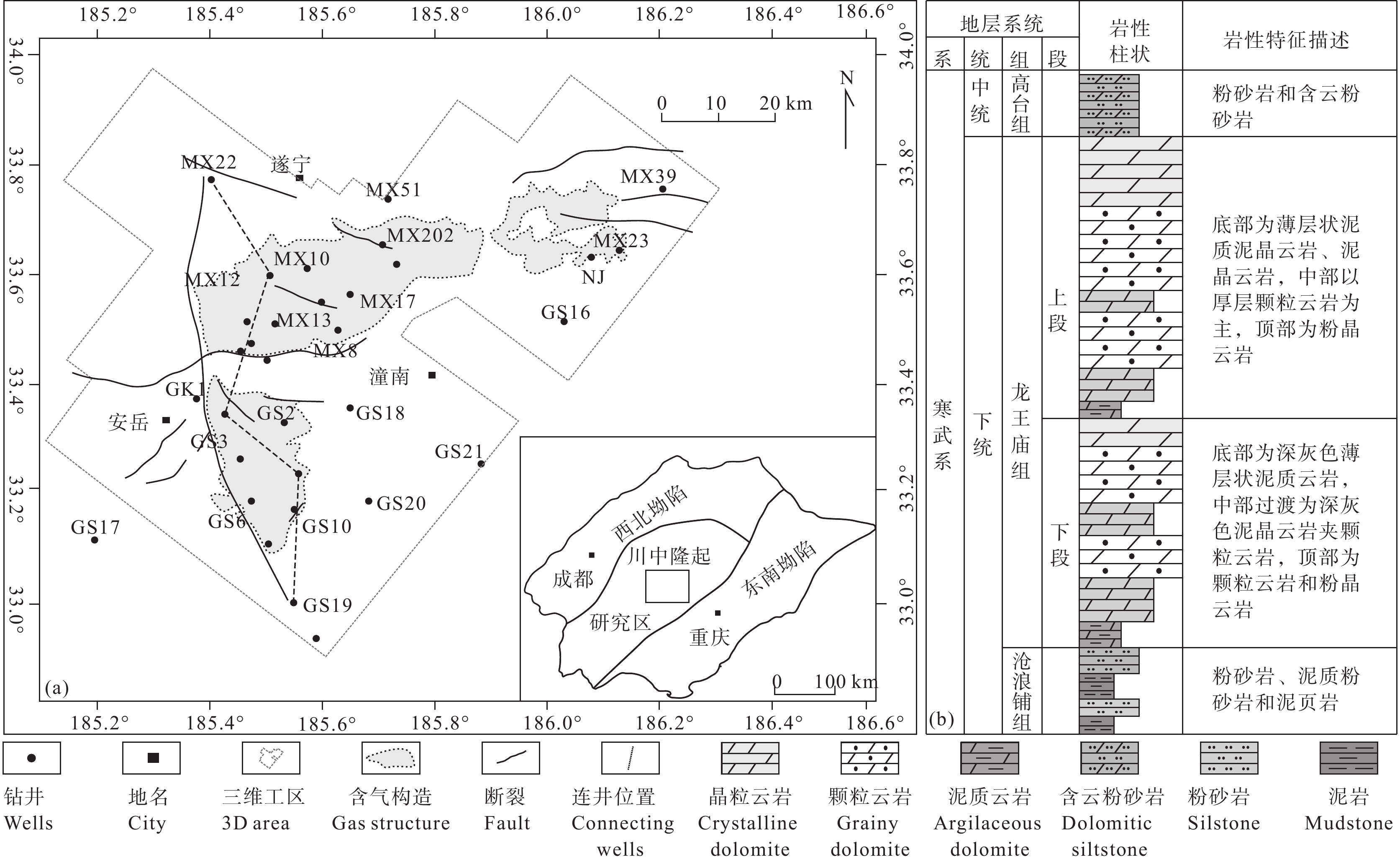
 下载:
下载:

